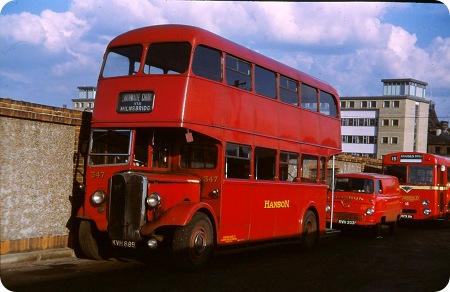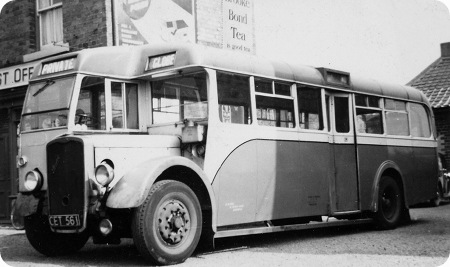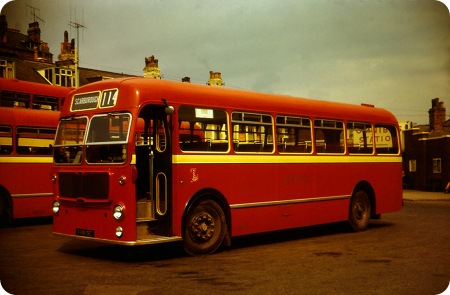Hanson – AEC/Hanson Regent – KVH 889 – 347
Hanson
1956
AEC/Hanson Regent
Roe H37/28R
This bus was originally a 1938 AEC Regal coach registration ACX903 fleet number 113 and it had a Plaxton C32F body. It was then rebodied by Duple in 1949 to a front entrance bus with 35 seats and renumbered 284. In 1956 the Duple Body was transferred to an ex Bottomleys Motors 1946 Maudslay Marathon lll chassis and numbered 305 with Hanson, a photo of which is here. The chassis was then rebodied by C.H. Roe and numbered 347 with a registration of KVH 889 and classed as a AEC/Hanson Regent H37/28R. On every picture I have seen of this bus the engine side panel is not fitting correctly, I wonder if it ever did.
My thanks go to the Hanson section of the website belonging to Huddersfield Passenger Transport Group for all the information.
———
18/05/12 – 12:20
Maybe the ill-fitting bonnet cover was caused by chassis sag, especially as it was a double-deck AEC Regal!
The unrelieved red does the vehicle no favours.
Chris Hebbron
———
19/05/12 – 07:37
The chassis of 347 was actually built up from components of two pre-war Regal chassis, 113 as stated above and ex Chapman’s Regal Burlingham coach VH 9101 of 1936 which was withdrawn in 1954 after an accident.
It was the first of twenty two AEC’s to get rebuilt by Hanson’s over the next ten years and was the only one, apart from fire victim 1964 Reliance rebuild 384, not to pass to Huddersfield Corporation in 1969.
347 is far from being unique for pre war style AEC’s running with the bonnet side hanging off. For example, there are several photos around of Tom Burrows, Barnsley, very similar bodied Regents with the same problem. I’m sure I’ve seen a picture of one of Burrows Regents even running with an ex STL bonnet side in the same position.
Even though it is forty six years since 347 was scrapped, and it was well passed it’s sell by date by then, I have fond memories of riding on it and listening to that melodious prewar manual gearbox.
Eric Bawden
———
19/05/12 – 09:16
Extant pictures of SUT Regals approaching (or beyond) withdrawal also show the dropped panel effect. Why? That I can’t say.
David Oldfield
———
19/05/12 – 09:17
These complex rebuilds are indeed really fascinating. At Samuel Ledgard’s we had a magnificent (I loved it) AEC "Regal" coach with Burlingham body – I wonder how many of its merry passengers knew that it was a Birmingham Corporation 1930 Regent 1 double decker !! As Eric says about the Hanson vehicle, its powerful engine and wonderful gearbox, perfectly serviceable but delightfully worn to a lovely tune, were a joy. Incredibly, as it was definitely a "one off", it was the subject of a Corgi model – a good model if you can forgive the Duple body instead of Burlingham and the registration number incorrect – FWJ 938, should be FJW 938 – ah well, better than nothing I suppose.
Chris Youhill
———
19/05/12 – 15:21
While I can’t recall seeing any ill-fitting bonnet sides like that shown, I can recall lots of London Transport’s veterans buses, in my childhood, which had unsecured bonnet sides propped up only by the nearside mudguard! Maybe this was to keep worn-out engines from over-heating!
Chris Hebbron
———
20/05/12 – 07:59
I always thought CVD6’s were meant to look like that!
Joe



